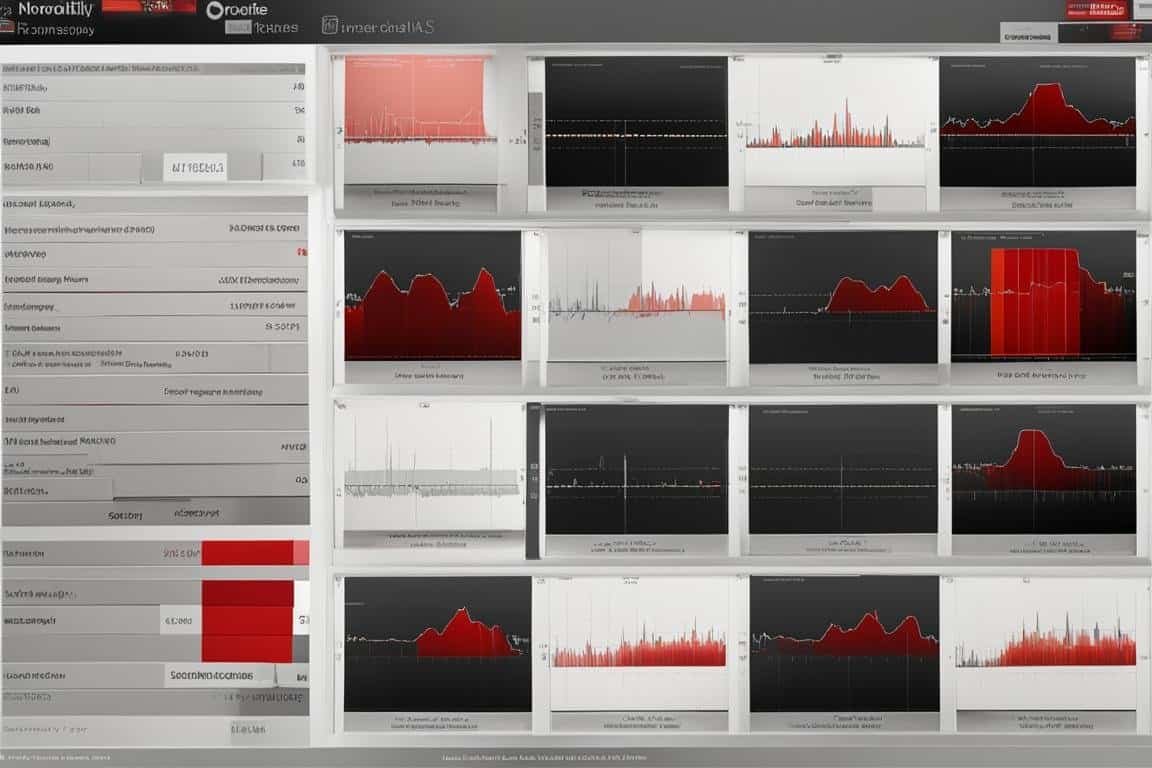In patients with acute coronary syndromes (ACS), the relationship between heart rate and mortality has been a subject of extensive research. Numerous studies conducted in populations across the world have consistently shown that elevated resting heart rate is an independent risk factor for cardiovascular disease. A higher heart rate has been associated with an increased risk of mortality not only in healthy individuals but also in those with known cardiovascular conditions such as hypertension and coronary artery disease.
Studies published in renowned journals like the American Heart Journal, European Heart Journal, and Lancet have highlighted the detrimental effects of an elevated heart rate on patient outcomes in ACS. Research conducted in French, Finnish, and American cohorts has demonstrated a clear link between higher heart rates and increased mortality rates in ACS patients.
Key Takeaways:
- Elevated resting heart rate is an independent risk factor for cardiovascular disease.
- Higher heart rates are associated with increased mortality in ACS patients.
- Studies in populations worldwide have consistently demonstrated this correlation.
- Understanding the relationship between heart rate and mortality aids in risk assessment and treatment strategies for ACS patients.
- Further research is needed to explore underlying mechanisms and potential interventions.
Impacts of Heart Rate on Mortality Rates in ACS Patients
Understanding the correlation between heart rate and mortality in acute coronary syndromes (ACS) is crucial for optimizing patient outcomes. Several studies have explored this relationship, shedding light on the significance of heart rate in predicting mortality rates in ACS patients.
A study conducted by the International Verapamil-SR/Trandolapril Study (INVEST) examined the impacts of heart rate on outcomes in hypertensive patients with coronary artery disease. The findings revealed that higher resting heart rates were associated with worse outcomes in this patient population, highlighting the importance of managing heart rate to improve prognosis.(Heart rate mortality correlation in acute coronary syndromes)
Further supporting evidence comes from research published in the Lancet, which identified heart rate as a prognostic risk factor in patients with coronary artery disease and left-ventricular systolic dysfunction. The study’s subgroup analysis showed that higher heart rates were associated with an increased risk of mortality in this specific patient group. These findings underscore the need for monitoring and managing heart rate in ACS patients with compromised ventricular function.(Heart rate and patient outcomes in ACS)
Another significant study, known as the GISSI experience, focused on myocardial infarction patients. The study demonstrated the relevance of heart rate as a prognostic factor, revealing that higher heart rates were associated with increased mortality rates. These findings emphasize the critical role of heart rate management in improving survival rates for ACS patients.(Heart rate mortality correlation in acute coronary syndromes)
To better understand the impacts of heart rate on mortality rates in ACS patients, it is essential to analyze the data and trends from these studies comprehensively. The table below summarizes the key findings and insights from the INVEST, Lancet, and GISSI experience studies.
| Study | Findings |
|---|---|
| INVEST | Higher resting heart rates associated with worse outcomes in hypertensive patients with coronary artery disease |
| Lancet | Heart rate is a prognostic risk factor in patients with coronary artery disease and left-ventricular systolic dysfunction; higher heart rates linked to increased mortality risk |
| GISSI experience | Heart rate is a prognostic factor in myocardial infarction patients; higher heart rates associated with increased mortality rates |
By closely examining the impacts of heart rate on mortality rates in ACS patients, healthcare professionals can enhance risk assessment and develop targeted strategies to optimize patient outcomes. Effective heart rate management plays a crucial role in improving survival rates and promoting better quality of life for individuals with acute coronary syndromes.
Heart Rate and Patient Mortality in Hypertensive Individuals
When it comes to heart rate and patient mortality, there is strong evidence indicating a significant relationship between the two. The Framingham Study, a long-term cohort study, revealed a notable association between heart rate and mortality in individuals with hypertension. The study found that higher heart rates were linked to increased mortality rates in this population. This emphasizes the importance of monitoring heart rate in hypertensive individuals as a potential indicator of patient outcomes and mortality risk.
Moreover, a study conducted in a French population further supported these findings. It identified heart rate as a significant predictor of mortality, particularly in older individuals with higher blood pressure levels. This suggests that heart rate can serve as a valuable parameter in assessing the prognosis and mortality risk in hypertensive patients, aiding healthcare professionals in developing appropriate treatment strategies.
Additionally, a study focusing on clinic and ambulatory heart rate in elderly subjects with systolic hypertension found that both measures were predictive of mortality. This highlights the importance of monitoring heart rate not only during clinical visits but also in everyday situations to evaluate potential risks and provide timely interventions.
Insights from the Framingham Study:
- Elevated heart rates are associated with increased mortality rates in individuals with hypertension.
- Regular monitoring of heart rate is crucial in assessing patient outcomes and mortality risk.
Findings in the French Population Study:
- Heart rate is a significant predictor of mortality, especially in older individuals with higher blood pressure.
Understanding the Clinic and Ambulatory Heart Rate:
- Clinic and ambulatory heart rate measurements can provide valuable insights into mortality risk in hypertensive individuals.
- Both clinic and ambulatory heart rate should be considered in evaluating patient prognosis and developing appropriate treatment strategies.

In summary, the impact of heart rate on mortality in hypertensive individuals is significant. Higher heart rates are associated with increased mortality rates in this population. Monitoring heart rate regularly and considering both clinic and ambulatory measurements can help assess patient outcomes and guide treatment decisions. By understanding the relationship between heart rate and mortality, healthcare professionals can intervene proactively and effectively manage the health of hypertensive patients.
Resting Heart Rate and Mortality in Patients with Acute Myocardial Infarction
Multiple studies have shown that resting heart rate plays a significant role in predicting mortality in patients with acute myocardial infarction (AMI). A study published in the American Heart Journal examined the relationship between heart rate at admission and patient outcomes in AMI cases. It found that heart rate was indeed a predictor of mortality in these patients.
The study also revealed an interesting pattern: patients with lower heart rates (
Further supporting the significance of heart rate in AMI, the GISSI-Prevenzione mortality risk chart, which used multiple-risk-factor assessment equations, identified heart rate as an important factor in assessing the absolute risk of death after myocardial infarction. This reinforces the notion that heart rate serves as a valuable cardiovascular risk factor in AMI patients.
In summary, understanding the resting heart rate of patients with acute myocardial infarction can provide crucial insights into their prognosis and risk of mortality. Monitoring and managing heart rate in AMI cases can help healthcare professionals make informed decisions and develop effective strategies to improve patient outcomes.
Heart Rate and Mortality in ACS Patients: Insights from Registries
The AMIS Plus registry has provided valuable insights into the relationship between heart rate and mortality in patients with acute coronary syndromes (ACS). This nationwide, prospective registry collects clinical data from patients admitted with acute myocardial infarction (AMI). The findings from this registry shed light on the impact of heart rate on patient outcomes in ACS.
According to the registry data, patients admitted with heart rates of less than 50 beats per minute (bpm) displayed higher rates of in-hospital adverse events compared to those with heart rates ranging from 50 to 100 bpm. This suggests that bradycardia (a heart rate below the normal range) at admission may be associated with an increased risk of complications during hospitalization.
However, it is important to note that after adjusting for relevant baseline differences, the association between bradycardia at admission and short-term mortality was found to be weak and not statistically significant. This indicates that while lower heart rates may be related to poorer outcomes in ACS patients, other factors may also contribute to mortality in this population.

Key Findings:
- Patients with heart rates
- After adjusting for relevant baseline differences, the association between bradycardia at admission and short-term mortality was weak and not statistically significant.
These insights from the AMIS Plus registry highlight the complex relationship between heart rate and mortality in ACS patients. It is important for healthcare professionals to consider various factors and individual patient characteristics when assessing the prognosis and developing treatment strategies for individuals with acute coronary syndromes.
Heart Rate and Mortality in ACS Patients: Global Perspective
The Global Atlas on Cardiovascular Disease Prevention and Control, published by the World Health Organization, sheds light on the significant burden of cardiovascular disease worldwide. This comprehensive report highlights the impact of acute coronary syndromes on mortality rates, emphasizing the need for effective management strategies.
Studies conducted in various populations, including India, Europe, and the United States, have consistently demonstrated a clear relationship between heart rate and patient mortality in acute coronary syndrome (ACS) cases. The findings from these studies have revealed that higher heart rates are associated with increased mortality rates in ACS patients.
Understanding the global perspective of heart rate and mortality in ACS is crucial to recognize the severity of the issue and develop targeted interventions. By identifying the role of heart rate in patient outcomes, healthcare professionals can better assess risks and design appropriate treatment plans to improve survival rates.
As we delve deeper into the global perspective, it becomes evident that addressing heart rate in ACS patients is of paramount importance. By focusing on reducing heart rate and mitigating associated risks, healthcare providers can play a pivotal role in enhancing patient outcomes and reducing mortality rates.
Conclusion
In conclusion, the evidence from multiple studies and registries strongly supports the significant impact of heart rate on mortality in patients with acute coronary syndromes (ACS). It has been consistently observed that individuals with higher resting heart rates experience worse patient outcomes and increased mortality rates in ACS cases. Understanding the relationship between heart rate and mortality is crucial for accurate risk assessment and the development of effective treatment strategies for patients with ACS.
Further research is necessary to delve into the underlying mechanisms and explore potential interventions that can improve outcomes for ACS patients. By uncovering the intricacies of this relationship, we can potentially identify novel targets for intervention and develop personalized treatment approaches that take heart rate into account. Such efforts have the potential to greatly enhance the quality of care and reduce mortality rates in this vulnerable patient population.
In summary, the significant impact of heart rate on mortality in ACS patients underscores the importance of monitoring and managing heart rate as part of a comprehensive approach to treating acute coronary syndromes. By targeting heart rate control, healthcare professionals can optimize patient outcomes and reduce the risk of mortality. Let us continue to pursue research, innovation, and evidence-based interventions to improve the lives of individuals affected by ACS.

